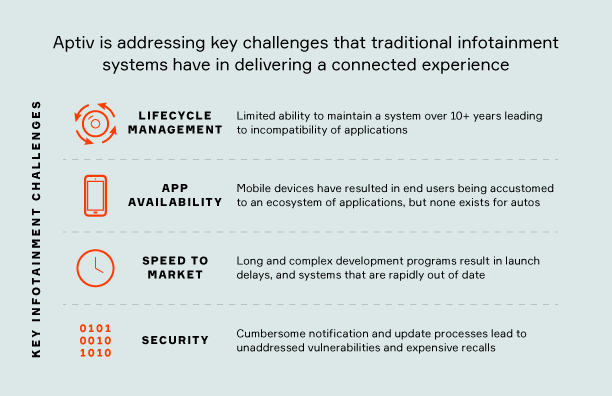Aptiv Builds First Infotainment System Powered by Android Automotive OS with Google Apps and Services Built-In
Empowering Vehicle Manufacturers to Better Control Their In-cabin Experience
Consider for a moment - which would you rather lose - your phone or your wallet? The reality for many of us is that smartphones have become central to how we manage our lives, and most of us would be lost without them! They connect us and also allow us to communicate with an increasing number of connected devices. This has given rise to a number of novel solutions; lights that turn on automatically when we get home, doorbells and locks that let us know when the kids get home from school, and voice-assistant technology.
Consumers increasingly expect that same level of digital experience in their vehicle, but what we often get is far from satisfying. We are presented with limited choices - often less than 5 to 10 applications - and the ones we do get are often incompatible or out of date. Even worse, poor data management and integration of software can open the door to bad actors and lead to cyber security and privacy threats, as well as expensive recalls.
The reality is that collaboration with leading service ecosystems - things like digital assistants, home automation systems, social media, or even mobility providers - is key to delivering connected solutions we all want. Collaboration favors open platforms, deeply integrated with the sensing, compute, and interface devices that support them. As a systems integrator with deep software and domain knowledge, Aptiv knows how to do this well, which is why when Volvo wanted to revolutionize how customers engage and interact with their cars, they turned to us.
Aptiv is delivering the world’s first vehicle infotainment solution powered by Android Automotive OS with Google apps and services built-in. The Polestar 2, followed shortly by the Volvo XC40, will be the first vehicles to natively support built-in access to services such as the Google Assistant, Google Maps, and Google Play Store.
Further, the Volvo XC40 is also the first Volvo to receive real-time over the air (OTA) software and operating system updates, as well as automotive apps created by the global Android developer community. That means the extensive catalog of popular apps that are already available - developed by Google, Volvo Cars, or third party app developers - will only continue to grow.
Android Automotive OS combined with OTA updates, will allow the vehicle to evolve and improve over time, maintaining a fresh solution over the life of the vehicle, rather than being at its peak when it leaves the factory. Or, as Volvo puts it, “A better car every day.” We couldn’t agree more!
However, what might be easy to miss in all of this is how the solution also empowered Volvo to focus on the unique experience and brand identity of their vehicle. By giving them back control of the differentiating software that powered the in-cabin user experience, we let Volvo decide how a Volvo should behave.
That meant that Aptiv could do what we do best - be a partner of choice, serving as the best bridge between auto and tech. Aptiv worked with Google and led the development and integration of Android Automotive OS with the Polestar 2 and Volvo XC40, while gaining early access to Android updates and features. We supported essential software requirements unique to automotive applications such as vehicle interface, comfort, and control, helping to improve the platform in the process.
Aptiv used an agile engineering framework - dubbed "Continuous Integration" - to bring this project to life, with engineers around the globe, in ‘scrums’ or teams. These teams collaborated with Volvo and Google to efficiently move this project on a rapid pace and flawless execution. If that sounds interesting, learn more here!

